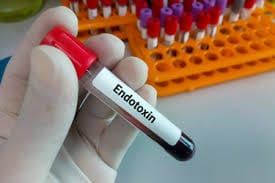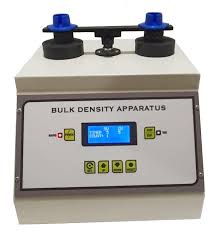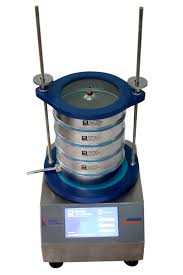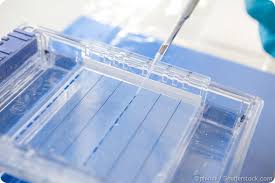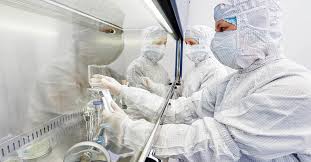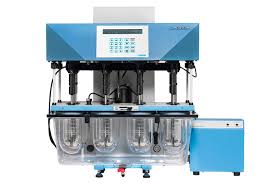|
Getting your Trinity Audio player ready... |
Karl Fischer Titration: A Detailed Overview
Karl Fischer Titration (KFT) is an analytical technique used primarily for the precise determination of water content in various substances. This method is vital in pharmaceutical, food, and chemical industries, where moisture content is a critical parameter for the quality of the product. The titration is based on a chemical reaction involving iodine and sulfur dioxide, in the presence of water, which results in the formation of sulfur trioxide and hydrogen iodide. This document aims to provide a detailed explanation of the principles, procedures, and applications of Karl Fischer titration, along with some technical insights into the reagents and equipment used.
1. Principle of Karl Fischer Titration
The core principle of Karl Fischer titration involves the oxidation reaction between iodine (I2) and sulfur dioxide (SO2). In the presence of water, these substances react to form sulfur trioxide (SO3) and hydrogen iodide (HI). The reaction is quantitative, meaning it can be used to determine the exact amount of water in a sample by measuring the amount of iodine consumed.
The reaction equation is as follows:
I2+SO2+H2O→2HI+SO3I_2 + SO_2 + H_2O → 2HI + SO_3I2+SO2+H2O→2HI+SO3
This reaction is sensitive to water content, and the endpoint is reached when all the water in the sample has reacted with iodine. This allows for an accurate measurement of water content in the sample.
2. Methods of Karl Fischer Titration
Karl Fischer titration can be carried out using two different methods, which are based on different ways of providing iodine for the reaction:
2.1. Volumetric Titration Method
In the volumetric titration method, iodine is dissolved in a solvent (typically methanol), and the sample is titrated with a Karl Fischer reagent. The amount of iodine consumed during the titration is proportional to the water content in the sample. The reagent contains iodine in a known concentration, and the titration continues until all the water has reacted, indicated by the endpoint of the titration.
The steps in the volumetric method include:
- Preparing the Karl Fischer reagent containing iodine.
- Adding a measured amount of sample to the reagent.
- Titrating the sample and determining the volume of reagent required to reach the endpoint.
The volume of titrant used allows for the calculation of the water content in the sample.
2.2. Coulometric Titration Method
In the coulometric method, iodine is generated in situ by electrolysis, where an iodine-containing reagent (usually potassium iodide) undergoes electrolysis to produce iodine. The amount of iodine generated is proportional to the amount of electricity passed through the solution. As iodine is produced, it reacts with water in the sample, and the endpoint is detected by measuring the total charge (in Coulombs) required to produce the iodine.
The coulometric method is more sensitive than the volumetric method and is often used for small samples or trace amounts of water. The process involves:
- Generating iodine through electrolysis.
- Reacting the iodine with water in the sample.
- Monitoring the charge required to produce the iodine and reach the endpoint.
3. Reagents Used in Karl Fischer Titration
The accuracy of Karl Fischer titration is highly dependent on the quality of the reagents used. The key ingredients in Karl Fischer reagents include:
- Iodine (I2): This is the titrant that reacts with water. Iodine is essential for the oxidation reaction during titration.
- Sulfur Dioxide (SO2): This compound reacts with iodine and water to form sulfur trioxide and hydrogen iodide.
- Buffer (Imidazole): The buffer helps maintain the proper pH level for the reaction to occur efficiently.
- Solvent (Methanol): Methanol is commonly used as the solvent in which the reagents are dissolved, providing a suitable medium for the reaction.
These reagents are mixed in specific proportions to ensure accurate titration results.
4. Water Equivalency Factor
The Water Equivalency Factor (WEF) is a crucial parameter in Karl Fischer titration that allows for the calculation of water content based on the titration results. The formula for the water equivalency factor is:
Water Equivalency Factor(F)=0.1566×WVWater \, Equivalency \, Factor (F) = \frac{0.1566 \times W}{V}WaterEquivalencyFactor(F)=V0.1566×W
Where:
- WWW is the weight of sodium tartrate in milligrams (mg).
- VVV is the volume of Karl Fischer reagent required for the titration (in milliliters, mL).
This factor is used to calculate the percentage of water content in a sample.
5. Calculating Water Content
Once the Water Equivalency Factor is determined, the water content in the sample can be calculated using the following formula:
% of Water Content=Volume Display×Water Equivalency Factor×100Weight of Sample in mg\% \, of \, Water \, Content = \frac{Volume \, Display \times Water \, Equivalency \, Factor \times 100}{Weight \, of \, Sample \, in \, mg}%ofWaterContent=WeightofSampleinmgVolumeDisplay×WaterEquivalencyFactor×100
Additionally, the water content can be expressed in parts per million (PPM) by using the following formula:
Water Content (PPM)=% of Water Content×10000Water \, Content \, (PPM) = \% \, of \, Water \, Content \times 10000WaterContent(PPM)=%ofWaterContent×10000
These calculations allow for precise quantification of the water content in the sample.
6. Types of Water Measured by Karl Fischer Titration
Karl Fischer titration can measure both free and bound water in a sample. This makes it a versatile method for analyzing different forms of water:
- Free Water: This is the water that is readily available and can be easily extracted from the sample, such as surface moisture.
- Bound Water: This refers to water that is chemically bound within the structure of the sample, such as water molecules trapped inside crystalline structures.
Karl Fischer titration is capable of detecting both types of water, providing a comprehensive analysis of the sample’s moisture content.
7. Advantages of Karl Fischer Titration
- Precision: Karl Fischer titration is known for its high accuracy in measuring water content, even in trace amounts.
- Rapid: The method is relatively quick, taking only a few minutes to complete, depending on the sample size.
- Versatile: It can be used to measure both free and bound water, making it suitable for a wide range of applications.
- Specific: The method is highly specific to water, meaning it can be used to measure moisture content without interference from other volatile substances.
8. Differences Between Karl Fischer Titration and Other Methods
Karl Fischer titration is often compared to other moisture determination methods, such as Loss on Drying (LOD). Here’s a quick comparison between the two:
| Feature | Karl Fischer Titration | Loss on Drying (LOD) |
| Water Content | Measures only water content | Measures all volatile components, including water |
| Method | Chemical reaction with iodine and sulfur dioxide | Heating to remove moisture |
| Time Required | Rapid (few minutes) | Longer (hours in some cases) |
| Accuracy | Very accurate for trace amounts of water | Less precise for small amounts of water |
9. Importance of Sodium Tartrate in Karl Fischer Titration
Sodium tartrate is a stabilizing agent used in the preparation of the Karl Fischer reagent. It is stable and non-hygroscopic, meaning it does not absorb moisture from the environment. This stability ensures that the reagent remains accurate and reliable during titration, making sodium tartrate an essential component in the preparation of Karl Fischer reagents.
10. Electrodes Used in Karl Fischer Titration
The Karl Fischer titration technique relies on the use of electrodes to detect the endpoint of the titration. The electrodes typically used are double platinum electrodes, which are resistant to corrosion and provide high sensitivity for detecting the end of the reaction. These electrodes are essential for the precise measurement of the iodine concentration in the solution.
11. Conclusion
Karl Fischer Titration is an indispensable tool for determining the water content in various samples. It provides accurate, rapid, and specific measurements of moisture levels, which is crucial for quality control in industries like pharmaceuticals, food processing, and chemicals. By understanding the principle, procedures, and reagents involved in this method, laboratories can ensure high-quality testing standards for water content analysis.
For those working with Karl Fischer titration in their labs, it is important to follow proper operational procedures and calibrations to achieve consistent and reliable results.




